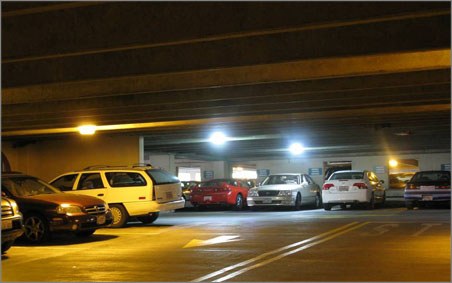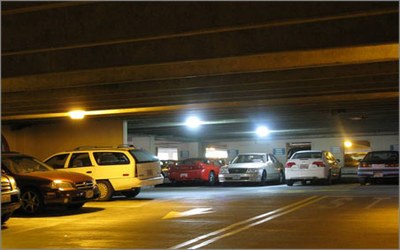DOE Report on LED Area Lights for a Commercial Garage Shows Good Acceptance
This U.S. Department of Energy GATEWAY Demonstration project studied the applicability of light-emitting diode (LED) luminaires for commercial parking garage applications. High-pressure sodium (HPS) area luminaires were replaced with new LED area luminaires. The project was supported under the U.S. Department of Energy (DOE) Solid-State Lighting Program. Other participants in the demonstration project included Providence Portland Medical Center in Portland, Oregon, the Energy Trust of Oregon, and Lighting Sciences Group (LSG) Inc. Pacific Northwest National Laboratory (PNNL) conducted the measurements and analysis of the results. PNNL manages GATEWAY demonstrations for DOE and represents their perspective in the conduct of the work.
Quantitative and qualitative measurements of light and electrical power were taken at the site for both HPS and LED light sources. Garage users’ responses to the new light sources were gauged with a survey.
Two versions of the LSG LED luminaires were used in this demonstration: an existing version (Version 1), which had been available on the market since 2007, and a newer version (Version 2), recently introduced, which has 30% more light output and uses about 8% less power. Six Version 1 luminaires were installed in the below-ground parking Level A, replacing six existing 150W HPS lamps spread out over two rows of parking spaces. Illuminance measurements were taken at floor level on an approximately 60-ft x 40-ft grid to measure the light output of these LED luminaires. Power measurements of the 6 LED luminaires were conducted, and it was determined that they drew an average of 82 W per fixture (versus 191 W for each of the HPS luminaire). Version 2 of the LSG luminaire was installed in Level B of the parking garage. Illuminance measurements were not made of this second luminaire on site due to higher traffic conditions; however, power and photometric measurements of this luminaire were made off-site by an independent laboratory.
Maximum and minimum light levels were measured for the HPS and LED Version 1 luminaires and projected for the Version 2 luminaires. Maximum light levels in foot-candles (fc) were 23.51 fc, 20.54 fc, and 26.7 fc respectively, and minimum light levels were 1.49 fc, 1.45 fc, and 1.88 fc. These results indicate very similar minimum light levels produced by Version 1 of the LED luminaires and HPS, and possibly slightly higher minimum light levels with Version 2 of the LED luminaires. All results were above the IES recommended level of 1 fc. User perceptions of the LED luminaires on Level B of the parking garage were collected via a written survey form given to maintenance and security personnel. More than half felt the LED luminaires provided more light than the HPS sources and a majority expressed a preference for the new fixtures when viewing the relamped area through a security camera. Respondents commented that the LED luminaires were less glary, created less shadows, had a positive impact on visibility, and improved the overall appearance of the area.
PNNL conducted an economic analysis and found that the Version 1 lamp produced annual energy savings of 955 kWh and annual energy cost savings of $62 per lamp at electricity rates of 6.5 cents per kWh (local rate), and $105.03 at 11 cents per kWh (national average rate). PNNL found that the Version 2 lamp produced annual energy savings of 991 kWh and energy cost savings of $64 per lamp at electricity rates of 6.5 cents per kWh and $109 at 11 cents per kWh. PNNL also calculated simple payback and found that Version 1 showed paybacks of 6.5 yrs at $0.065/kWh and 4.1 yrs at $0.11/kWh while Version 2 showed paybacks of 6.3 yrs at $0.065/kWh and 3.9 yrs at $0.11/kWh.
Tis and additional LED reports are available for download at www.netl.doe.gov/ssl.
Download report: Commercial Garage LED Lighting Demonstration


